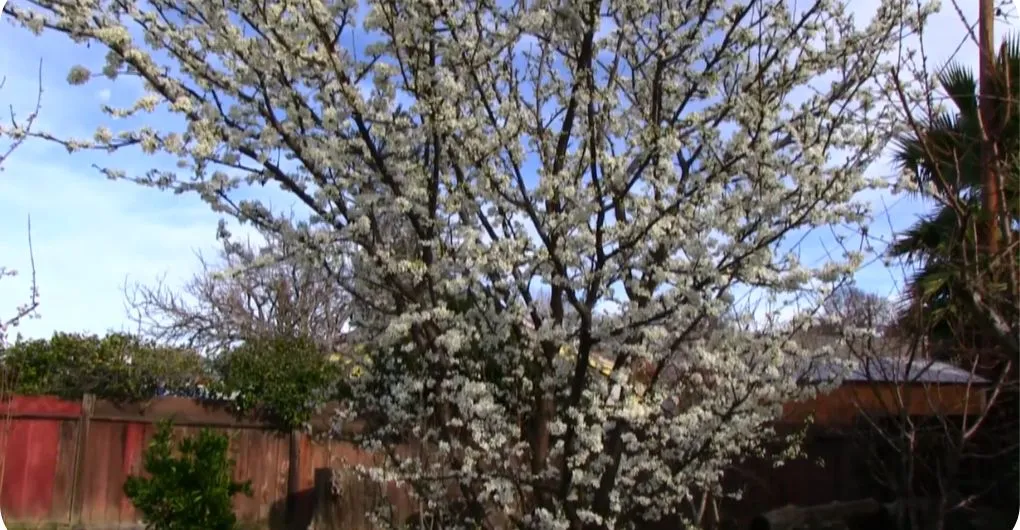Many gardeners and orchardists look forward to the springtime, when plum trees burst into bloom, covering themselves in a profusion of delicate flowers. But exactly, “when does a plum tree bloom?”
Today I will explore the timing of the plum tree blossoms and what factors affect their appearance.
When does a Plum tree Bloom?
Depending on the region and temperature, plum trees typically bloom around March or April. The flowering season may differ depending on the kind of plum tree and the specific climatic conditions in which it is grown. The amount of sunlight, temperature and climate all affect when plum trees bloom.
One of the crucial elements in figuring out when a tree will bloom is the number of incredible hours it endures. Chill hours is the duration of hours the tree is exposed to temperatures between 32°F and 45°F. Plum trees require a precise number of chilly hours to break dormancy and bloom successfully.
Depending on the species of the plum tree, the required chilling period can vary. However, it usually falls between 800 and 1,200 hours.
Plum trees come in a wide range of kinds, each with its personality and blooming season. Some of the most famous plum tree varieties include the Santa Rosa, the Methley, and the Burbank.
The Santa Rosa is a popular plum tree variety that produces large, juicy fruit with reddish-purple skin and yellow flesh. In California, this cultivar blooms typically in the middle to end of February and might last for several weeks. The Santa Rosa requires about 300-400 chilling hours to bloom.
The Methley is another popular plum tree variety that produces small to medium-sized fruit with dark red skin and sweet, juicy flesh. This particular type usually blooms in late February or early March and needs 250–300 cooling hours to do so.
The Burbank is a third popular plum tree variety that produces large, red fruit with a sweet, flavorful taste. This variety usually blooms in the first few days of March and needs between 400 and 500 cooling hours to do so.
When does a Chickasaw plum tree bloom?
The Chickasaw Plum tree (Prunus angustifolia) typically blooms in early spring, usually in March or April. Depending on the location and the local weather, the bloom’s exact timing may change. The tree may bloom as early as February in some warmer climates, while it may not bloom until later in the spring in cooler climates. For bees and other pollinators, the tiny, white blossoms provide a significant source of early nectar and pollen. So, that they can carry successful pollination.
When Do plums Bloom? Blooming stages
- First stage: Dormancy
Dormancy is the initial phase of blossoming. This occurs during the winter when the tree is in a state of rest. The tree looks dead throughout this time and shows no signs of fresh growth or activity. However, the tree is conserving energy and getting ready for the following development stage.
- Second Stage: Bud Swelling
The tree’s buds grow as winter gives way to spring. This indicates that the tree is emerging from dormancy and preparing for blossom. Initially, the buds are typically tiny and constrictive. Still, with time they will progressively expand and swell as the tree gets ready to burst into bloom.
- Third Stage: Green Tip
The buds will start to display a tiny bit of green at the tip once they have grown to a certain extent. This indicates that the tree is getting ready to generate buds and leaves. It’s crucial to monitor the weather throughout this phase. The buds on the tree may be harmed by a late frost or a sharp drop in temperature, which will prevent the tree from blossoming.
- Stage 4: Visible Florets
The florets can be seen individually as the buds continue to grow. The tree will soon be covered in these tiny, beautiful blossoms. At this time, it’s crucial to make sure that the tree has adequate water and nutrients to support sustainable growth. Additionally, you might want to think about applying a fertilizer made especially for fruit plants.
- Stage 5: Complete Bloom
Full bloom is the last stage of blossoming. When the tree is covered in an abundance of delicate blooms, that is. The flowers often have a lovely, delicate aroma and are pink or white. Although this is a stunning sight, it’s vital to keep in mind that the blossoms are delicate and are easily harmed by wind or rain.
How Do the Plum Tree Blossoms Look?
The Plum blossoms are often simple and modest, with five delicate petals that are either pink or light-colored white. The petals are rounded and have a slight bend that faces the center of the bud. These trees have a profusion of these delicate blooms when they are in full bloom, which makes for a stunning display of the beauty of nature. A plum tree that is fully bloomed is undoubtedly a visual treat and proof that spring has finally sprung.

What Should You Do if There Is a Late Frost?
A late frost can be troublesome for your garden if you are planting your plants outdoors. But you can do the following things to prevent the damage from spreading:
Cover your plants: Plants particularly susceptible to frost, such as new seedlings or delicate flowers, should be covered with a blanket or tarp. This will assist in keeping them slightly warmer and shield them from frost.
Water your plants: Water your plants thoroughly before the frost. Because damp soil holds onto heat better than dry soil, it may help keep the plants warmer.
Bring potted plants inside: If you have any potted plants outdoors, bring them inside or put them somewhere safe, such as a garage or covered porch. This will aid in defending them against the frost.
Prune damaged parts: Trim away damaged areas after the frost by examining your plants and removing any affected areas. This will aid in halting the frost damage and promote new growth.
What month do plum trees produce fruit?
Generally speaking, plum trees begin to bear fruit in the early summer or late spring. This can happen anywhere from May through June. However, the exact time when the fruit is ripe and ready for harvest can vary depending on the type and other growing circumstances.
While some plum varieties might not be ripe until late summer or early fall, others might be as early as late May. The fruit can be harvested as early as June or as late as September, depending on the type of tree and the local temperature.
When Do Dwarf Plum Trees Produce Fruit?
Even though dwarf plum trees can begin bearing fruit as early as 2 – 3 years after planting, it may take the tree up to 5 years to yield a sizable crop. Remember that young fruit trees should have their fruit thinned in the first few years to aid in growing the tree’s sturdy root and trunk systems.
Do plum trees produce fruit every year?
The short answer is that plum trees can produce fruit every year, but this can depend on a few different factors.
The weather is one of the most important variables that can impact a tree’s ability to produce fruit. For their fruit to be fully set, the trees need a certain number of cool hours throughout the winter. The tree may not produce as much fruit, or the fruit may be smaller if they don’t get enough excellent hours.
Therefore, it’s crucial to give your plum tree the proper attention and maintenance if you want it to bear fruit every year. Regular watering, fertilization, pruning to encourage healthy development, and watching for disease or pest infestation indicators are all part of this.
Note: If you are wondering about growth and maintenance requirements for plum trees. I have a whole section for that in the next step.
How Fast do plum trees grow from seed?
Plum trees can take several years to grow from seed to a size where they can produce fruit.
On average, it takes about 3-6 years for a plum tree to develop from seed to a size where it may bear fruit. In its first year of life, the seedling may hardly grow in height by a few inches. In the second year, the tree might grow to a height of one to two feet; by the third year, it might be three to four feet tall. However, it might require longer than three years to mature, develop strong roots, and be prepared to produce fruit.
Remember that starting a plum tree from seed might be difficult since the tree might not produce fruit that is exactly like the parent tree. It might take longer to produce fruit than if you started with a grafted tree.
Tips for encouraging plum tree blooming
Prune your tree: Your plum tree needs to be pruned to promote blossoming. Before the tree starts to bud, pruning should be carried out in the early spring or winter. Trim the tree to remove any diseased, broken, or dead branches. The tree will be able to concentrate its energy on growing new branches and blossoms as a result.
Fertilize your plum tree: Before your tree blossoms in the spring and again after it loses its leaves in the fall, fertilize it. Use a balanced fertilizer for proper effect.
Water your plum tree: Plum trees require regular irrigation. Once a week, especially during dry seasons, deeply water your tree. But refrain from overwatering to prevent root rot.
Provide Sunlight: The right amount of sunlight should be provided for plum trees to bloom. A minimum of six hours of direct sunlight should be received by the tree every day when it is planted.
Eliminate pests and diseases: They can prevent your plum tree from blooming. Regularly inspect your tree for symptoms of pests and diseases, then take the necessary steps to control them.
When does a plum tree bloom? Conclusion
Our topic, “when does a plum tree bloom?” comes to an end. To conclude, plum tree bloom time depends on various factors, but ideally, it blooms around March or April. I hope the data I shared in this post was valuable. If you have further inquiries, you can ask me in the comments. Thank you!
Each fruit tree has its bloom time and attractiveness. Read my other articles to learn more:





